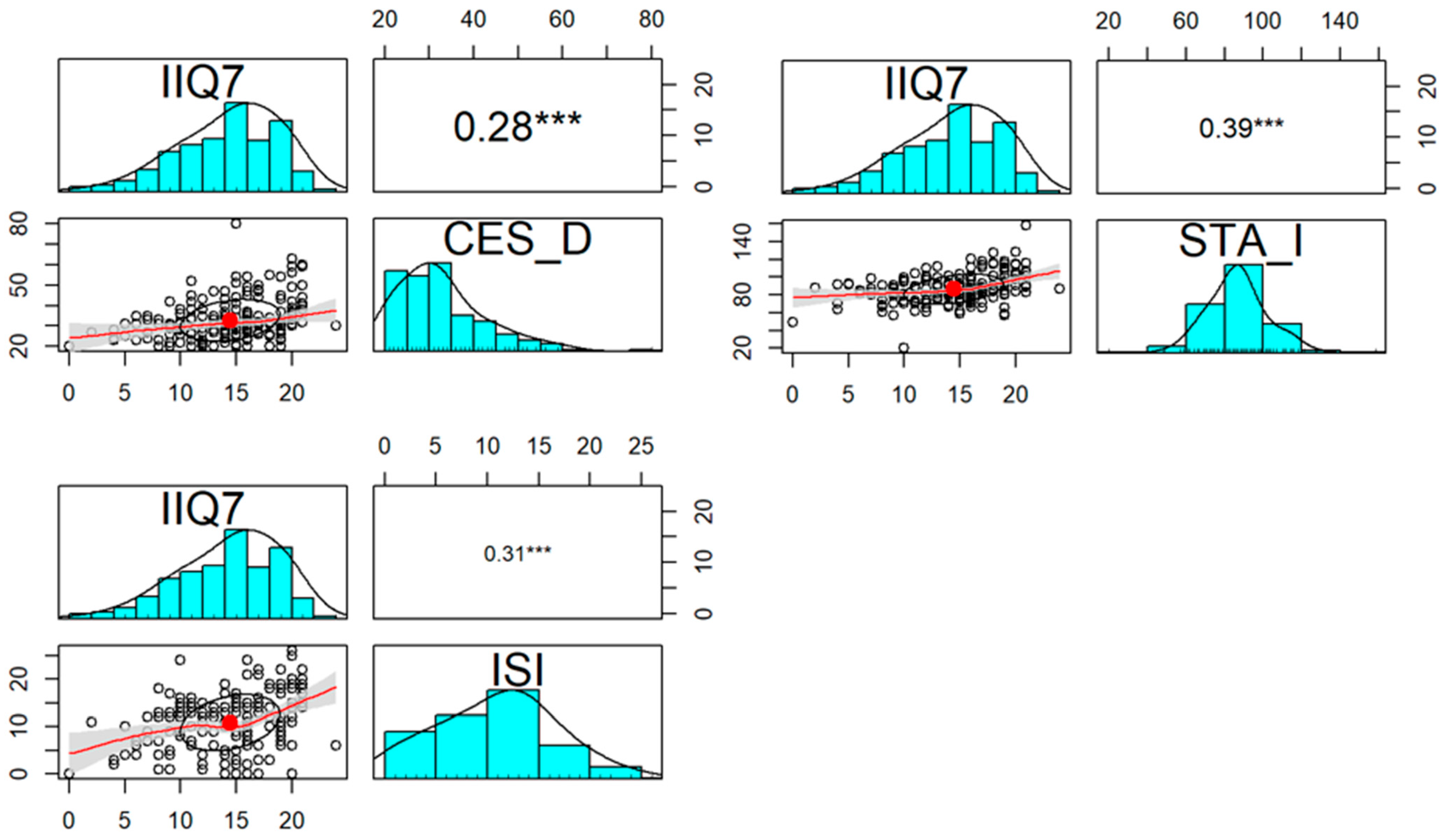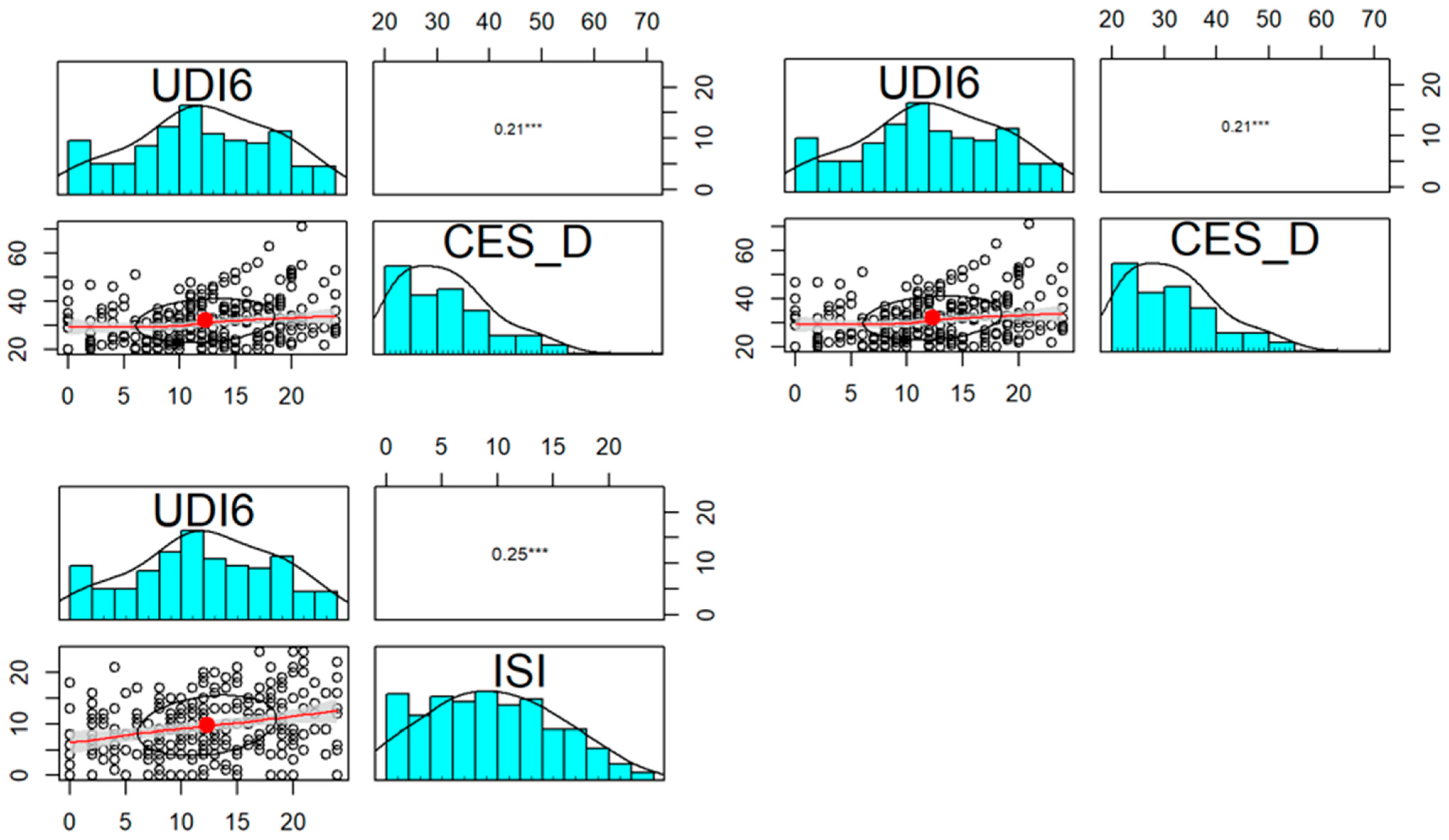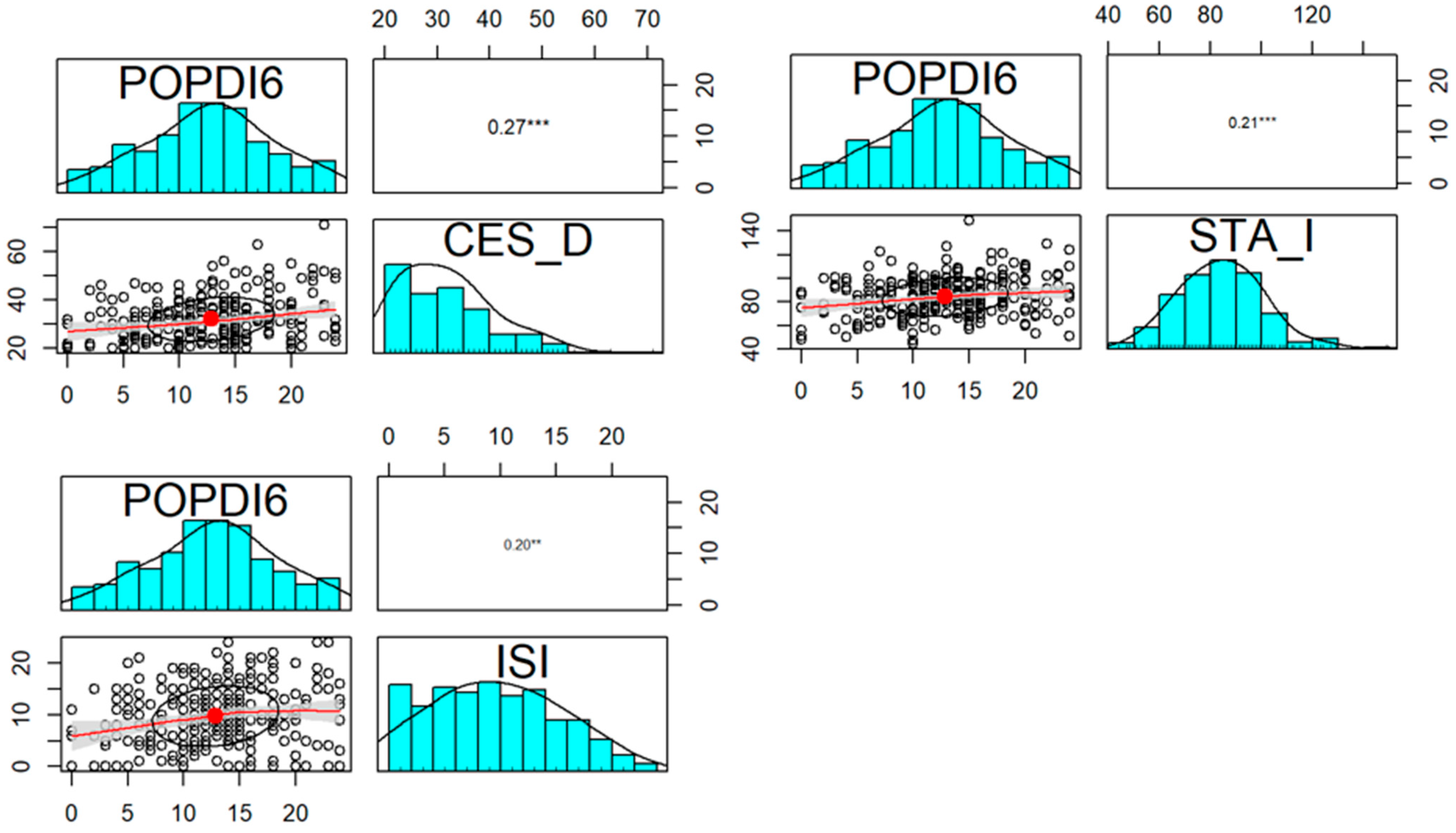Influence of Stress Urinary Incontinence and Pelvic Organ Prolapse on Depression, Anxiety, and Insomnia—A Comparative Observational Study
Abstract
1. Introduction
2. Materials and Methods
- The control group consisted of patients without PFDs who attended the clinic for colposcopy, PAP smear, or ultrasound examination with no pathologies found both where PFDs and other gynecological problems were concerned.
- SUI group: patients with bothering SUI (everyday leakage, daily use of absorbent pads, positive caught test).
- POP group: patients with symptomatic prolapse (POPQ > 2) (feeling of bulge, urination or defecation disorders, urgency, impaired sexual activity).
3. Results
4. Discussion
5. Conclusions
Author Contributions
Funding
Institutional Review Board Statement
Informed Consent Statement
Data Availability Statement
Conflicts of Interest
References
- Dieter, A.A.; Wilkins, M.F.; Wu, J.M. Epidemiological trends and future care needs for pelvic floor disorders. Curr. Opin. Obstet. Gynecol. 2015, 27, 380–384. [Google Scholar] [CrossRef] [PubMed]
- Bradley, C.S.; Brown, H.W.; Shippey, S.S.; Gutman, R.E.; Andy, U.U.; Yurteri-Kaplan, L.A.; Kudish, B.; Mehr, A.; O’boyle, A.; Foster, R.T.; et al. Generic Health-Related Quality of Life in Patients Seeking Care for Pelvic Organ Prolapse. Urogynecology 2021, 27, 337–343. [Google Scholar] [CrossRef] [PubMed]
- Quaghebeur, J.; Petros, P.; Wyndaele, J.-J.; De Wachter, S. Pelvic-floor function, dysfunction, and treatment. Eur. J. Obstet. Gynecol. Reprod. Biol. 2021, 265, 143–149. [Google Scholar] [CrossRef] [PubMed]
- De Arruda, G.T.; Paines, G.P.; da Silva, B.R.; Pairé, L.X.; Pivetta, H.M.F.; Braz, M.M.; Virtuoso, J.F. Relationship Involving Sexual Function, Distress Symptoms of Pelvic Floor Dysfunction, and Female Genital Self-Image. Rev. Bras. Ginecol. Obs. 2023, 45, e542–e548. [Google Scholar] [CrossRef] [PubMed]
- Jacomo, R.H.; Alves, A.T.; Garcia, P.A.; da Silva, M.L.; Matheus, L.B.G.; Lorena, D.C.R.; de Sousa, J.B. Risk factors for mild depression in older women with overactive bladder syndrome—A cross sectional study. PLoS ONE 2020, 15, e0227415. [Google Scholar] [CrossRef] [PubMed]
- Melotti, I.G.R.; Juliato, C.R.T.; Tanaka, M.; Riccetto, C.L.Z. Severe depression and anxiety in women with overactive bladder. Neurourol. Urodyn. 2018, 37, 223–228. [Google Scholar] [CrossRef] [PubMed]
- Tzeng, N.-S.; Chang, H.-A.; Chung, C.-H.; Kao, Y.-C.; Yeh, H.-W.; Yeh, C.-B.; Chiang, W.-S.; Huang, S.-Y.; Lu, R.-B.; Chien, W.-C. Risk of Psychiatric Disorders in Overactive Bladder Syndrome: A Nationwide Cohort Study in Taiwan. J. Investig. Med. 2019, 67, 312–318. [Google Scholar] [CrossRef]
- Kim, K.S.; Moon, H.S. Antimuscarinic Agent Treatment Affecting Patient-Reported Outcomes in Overactive Bladder Syndrome with Depressive Symptoms. Int. Neurourol. J. 2016, 20, 349–355. [Google Scholar] [CrossRef][Green Version]
- Jurášková, M.; Piler, P.; Kukla, L.; Švancara, J.; Daňsová, P.; Hruban, L.; Kandrnal, V.; Pikhart, H. Association between Stress Urinary Incontinence and Depressive Symptoms after Birth: The Czech ELSPAC Study. Sci. Rep. 2020, 10, 6233. [Google Scholar] [CrossRef]
- Monz, B.; Pons, M.E.; Hampel, C.; Hunskaar, S.; Quail, D.; Samsioe, G.; Sykes, D.; Wagg, A.; Papanicolaou, S. Patient-reported impact of urinary incontinence—Results from treatment seeking women in 14 European countries. Maturitas 2005, 52, S24–S34. [Google Scholar] [CrossRef]
- Steibliene, V.; Aniuliene, R.; Aniulis, P.; Raskauskiene, N.; Adomaitiene, V. Affective Symptoms and Health-Related Quality of Life Among Women with Stress Urinary Incontinence: Cross-Sectional Study. Neuropsychiatr. Dis. Treat. 2020, 16, 535–544. [Google Scholar] [CrossRef] [PubMed]
- Vikström, N.H.; Wasteson, E.; Lindam, A.; Samuelsson, E. Anxiety and depression in women with urinary incontinence using E-health. Int. Urogynecol. J. 2021, 32, 103–109. [Google Scholar] [CrossRef] [PubMed]
- Moon, H.; Park, Y.; Kim, M.; Lee, S. Interaction and main effects of physical and depressive symptoms on quality of life in Korean women seeking care for rectal prolapse: A cross-sectional observational study. Korean J. Women Health Nurs. 2021, 27, 297–306. [Google Scholar] [CrossRef] [PubMed]
- Ai, F.-F.; Mao, M.; Zhang, Y.; Kang, J.; Zhu, L. Effect of generalized anxiety disorders on the success of pessary treatment for pelvic organ prolapse. Int. Urogynecol. J. 2018, 29, 1147–1153. [Google Scholar] [CrossRef] [PubMed]
- Oliphant, S.S.; Lowder, J.L.; Lee, M.; Ghetti, C. Most older women recover baseline functional status following pelvic organ prolapse surgery. Int. Urogynecol. J. 2014, 25, 1425–1432. [Google Scholar] [CrossRef]
- Mama, S.T.; Regmi, M.C. Pelvic Floor Disorders/Obstetric Fistula. Obstet. Gynecol. Clin. North Am. 2022, 49, 735–749. [Google Scholar] [CrossRef]
- Cox, C.K.; Schimpf, M.O.; Berger, M.B. Stigma Associated with Pelvic Floor Disorders. Urogynecology 2020, 27, e453–e456. [Google Scholar] [CrossRef]
- Siyoum, M.; Teklesilasie, W.; Alelgn, Y.; Astatkie, A. Inequality in healthcare-seeking behavior among women with pelvic organ prolapse: A systematic review and narrative synthesis. BMC Women’s Health 2023, 23, 222. [Google Scholar] [CrossRef]
- Choi, E.P.; Lam, C.L.; Chin, W.Y. Mental Health mediating the relationship between symptom severity and health-related quality of life in patients with lower urinary tract symptoms. Low. Urin. Tract. Symptoms 2015, 8, 141–149. [Google Scholar] [CrossRef]
- Vardeman, J.; Spiers, A.; Yamasaki, J. “Things Are Happening That I Don’t Understand”: A Narrative Exploration of the Chaos of Living with Pelvic Floor Disorders. Health Commun. 2022, 38, 1887–1895. [Google Scholar] [CrossRef]
- Stickley, A.; Santini, Z.I.; Koyanagi, A. Urinary incontinence, mental health and loneliness among community-dwelling older adults in Ireland. BMC Urol. 2017, 17, 29. [Google Scholar] [CrossRef] [PubMed]
- Huang, C.L.-C.; Ho, C.-H.; Weng, S.-F.; Hsu, Y.-W.; Wang, J.-J.; Wu, M.-P. The association of healthcare seeking behavior for anxiety and depression among patients with lower urinary tract symptoms: A nationwide population-based study. Psychiatry Res. 2015, 226, 247–251. [Google Scholar] [CrossRef] [PubMed]
- Zuluaga, L.; Caicedo, J.I.; Mogollón, M.P.; Santander, J.; Bravo-Balado, A.; Trujillo, C.G.; Ritter, C.D.; Rondón, M.; Plata, M. Anxiety and depression in association with lower urinary tract symptoms: Results from the COBaLT study. World J. Urol. 2023, 41, 1381–1388. [Google Scholar] [CrossRef] [PubMed]
- Demirci, A.; Hızlı, F.; Hamurcu, H.D.; Başar, H. Which type of female urinary incontinence has more impact on pelvic floor and sexual function in addition to anxiety and depression symptoms: A questionnaire-based study. Neurourol. Urodyn. 2023, 42, 814–821. [Google Scholar] [CrossRef] [PubMed]
- Pizarro-Berdichevsky, J.; Hitschfeld, M.J.; Pattillo, A.; Blumel, B.; Gonzalez, S.; Arellano, M.; Cuevas, R.; Alvo, J.; Gorodischer, A.; Flores-Espinoza, C.; et al. Association between pelvic floor disorder symptoms and QoL scores with depressive symptoms among pelvic organ prolapse patients. Aust. N. Z. J. Obstet. Gynaecol. 2016, 56, 391–397. [Google Scholar] [CrossRef] [PubMed]
- Ai, F.; Deng, M.; Mao, M.; Xu, T.; Zhu, L. Depressive symptoms screening in postmenopausal women with symptomatic pelvic organ prolapse. Menopause 2018, 25, 314–319. [Google Scholar] [CrossRef] [PubMed]
- Ai, F.; Deng, M.; Mao, M.; Xu, T.; Zhu, L. Screening for general anxiety disorders in postmenopausal women with symptomatic pelvic organ prolapse. Climacteric 2017, 21, 35–39. [Google Scholar] [CrossRef]
- Lai, H.H.; Rawal, A.; Shen, B.; Vetter, J. The Relationship Between Anxiety and Overactive Bladder or Urinary Incontinence Symptoms in the Clinical Population. Urology 2016, 98, 50–57. [Google Scholar] [CrossRef]
- Drage, K.; Aghera, M.; MacKellar, P.; Twentyman, R.; Jacques, A.; Chalmers, K.J.; Neumann, P.; Nurkic, I.; Thompson, J. The relationship between symptom severity, bother and psychological factors in women with pelvic organ prolapse: A cross-sectional observational study. Neurourol. Urodyn. 2021, 41, 423–431. [Google Scholar] [CrossRef]
- Shon, D.; Kim, S.J.; Cheon, E.-J.; Kang, S.I.; Kim, S. Prevalence and risk factors associated with depressive mood in Korean patients with fecal incontinence. Ann. Surg. Treat. Res. 2021, 101, 181–186. [Google Scholar] [CrossRef]
- Pierce, H.; Perry, L.; Gallagher, R.; Chiarelli, P. Urinary incontinence, work, and intention to leave current job: A cross sectional survey of the Australian nursing and midwifery workforce. Neurourol. Urodyn. 2017, 36, 1876–1883. [Google Scholar] [CrossRef] [PubMed]




| Control Group (n = 191) | SUI Group (n = 192) | POP Group (n = 271) | |
|---|---|---|---|
| Age (years) | 48.5 ± 14 | 53.3 ± 11.3 ns | 60.9 ± 11.7 p < 0.05 |
| BMI | 29.3 ± 8.4 | 28.5 ± 9.3 ns | 29.1 ± 9.4 ns |
| Parity (no of deliveries) | 1.89 ± 2.3 | 1.89 ± 1.3 ns | 1.96 ± 2.8 ns |
| Mean duration of symptoms (years) | 4.31 ± 4.12 ns | 5.34 ± 3.21 ns | |
| Diabetes mellitus type II (%) | 9.1 | 11.1 | 12.2 |
| Hypertension (%) | 7.5 | 9.0 | 8.7 |
| Postmenopausal status (%) | 54 | 61 ns | 67 p < 0.05 |
| IIQ7_1 | IIQ7_2 | IIQ7_3 | IIQ7_4 | IIQ7_5 | IIQ7_6 | IIQ7_7 | IIQ7 | |
|---|---|---|---|---|---|---|---|---|
| STA_I | 0.228 p < 0.05 | 0.115 ns | 0.196 p < 0.05 | 0.197 p < 0.05 | 0.276 p < 0.05 | 0.463 p < 0.05 | 0.363 p < 0.05 | 0.383 p < 0.05 |
| ISI | 0.339 p < 0.05 | 0.125 ns | 0.198 p < 0.05 | 0.254 p < 0.05 | 0.173 p < 0.05 | 0.252 p < 0.05 | 0.178 p < 0.05 | 0.309 p < 0.05 |
| CES_D | 0.2357 p < 0.05 | 0.119 ns | 0.240 p < 0.05 | 0.137 p < 0.05 | 0.199 p < 0.05 | 0.314 p < 0.05 | 0.223 p < 0.05 | 0.307 p < 0.05 |
| POPDI_1 | POPDI_2 | POPDI_3 | POPDI_4 | POPDI_5 | POPDI_6 | |
|---|---|---|---|---|---|---|
| STA_I | 0.245 p < 0.05 | 0.321 p < 0.05 | 0.150 p < 0.05 | 0.072 ns | 0.12 ns1 | 0.082 ns |
| ISI | 0.194 p < 0.05 | 0.094 Ns | 0.087 ns | 0.060 ns | 0.221 p < 0.05 | 0.147 ns |
| CES_D | 0.274 p < 0.05 | 0.235 p < 0.05 | 0.050 ns | 0.123 ns | 0.159 p < 0.05 | 0.236 p < 0.05 |
| UDI_1 | UDI_2 | UDI_3 | UDI_4 | UDI_5 | UDI_6 | |
|---|---|---|---|---|---|---|
| STA_I | 0.022 ns | 0.009 ns | 0.122 ns | 0.138 p < 0.05 | 0.020 ns | 0.217 p < 0.5 |
| ISI | 0.118 ns | 0.027 ns | 0.190 p < 0.05 | 0.134 ns | 0.131 ns | 0.287 p < 0.05 |
| CES_D | 0.038 ns | 0.060 ns | 0.180 p < 0.05 | 0.131 ns | 0.083 ns | 0.221 p < 0.05 |
| CRADI_1 | CRADI_2 | CRADI_3 | CRADI_4 | CRADI_5 | CRADI_6 | CRADI_7 | CRADI_8 | |
|---|---|---|---|---|---|---|---|---|
| STA_I | 0.140 p < 0.05 | 0.189 p < 0.05 | 0.094 ns | 0.163 p < 0.05 | 0.242 p < 0.05 | 0.128 ns | 0.194 p < 0.05 | 0.101 ns |
| ISI | 0.210 p < 0.05 | 0.176 p < 0.05 | 0.138 p < 0.05 | 0.103 ns | 0.158 p < 0.05 | 0.164 p < 0.05 | 0.208 p < 0.05 | 0.164 p < 0.05 |
| CES_D | 0.182 p < 0.05 | 0.168 p < 0.05 | 0.149 p < 0.05 | 0.124 ns | 0.185 p < 0.05 | 0.184 p < 0.05 | 0.172 p < 0.05 | 0.127 ns |
Disclaimer/Publisher’s Note: The statements, opinions and data contained in all publications are solely those of the individual author(s) and contributor(s) and not of MDPI and/or the editor(s). MDPI and/or the editor(s) disclaim responsibility for any injury to people or property resulting from any ideas, methods, instructions or products referred to in the content. |
© 2023 by the authors. Licensee MDPI, Basel, Switzerland. This article is an open access article distributed under the terms and conditions of the Creative Commons Attribution (CC BY) license (https://creativecommons.org/licenses/by/4.0/).
Share and Cite
Kalata, U.; Pomian, A.; Jarkiewicz, M.; Kondratskyi, V.; Lippki, K.; Barcz, E. Influence of Stress Urinary Incontinence and Pelvic Organ Prolapse on Depression, Anxiety, and Insomnia—A Comparative Observational Study. J. Clin. Med. 2024, 13, 185. https://doi.org/10.3390/jcm13010185
Kalata U, Pomian A, Jarkiewicz M, Kondratskyi V, Lippki K, Barcz E. Influence of Stress Urinary Incontinence and Pelvic Organ Prolapse on Depression, Anxiety, and Insomnia—A Comparative Observational Study. Journal of Clinical Medicine. 2024; 13(1):185. https://doi.org/10.3390/jcm13010185
Chicago/Turabian StyleKalata, Urszula, Andrzej Pomian, Michał Jarkiewicz, Vitalii Kondratskyi, Krzysztof Lippki, and Ewa Barcz. 2024. "Influence of Stress Urinary Incontinence and Pelvic Organ Prolapse on Depression, Anxiety, and Insomnia—A Comparative Observational Study" Journal of Clinical Medicine 13, no. 1: 185. https://doi.org/10.3390/jcm13010185
APA StyleKalata, U., Pomian, A., Jarkiewicz, M., Kondratskyi, V., Lippki, K., & Barcz, E. (2024). Influence of Stress Urinary Incontinence and Pelvic Organ Prolapse on Depression, Anxiety, and Insomnia—A Comparative Observational Study. Journal of Clinical Medicine, 13(1), 185. https://doi.org/10.3390/jcm13010185







